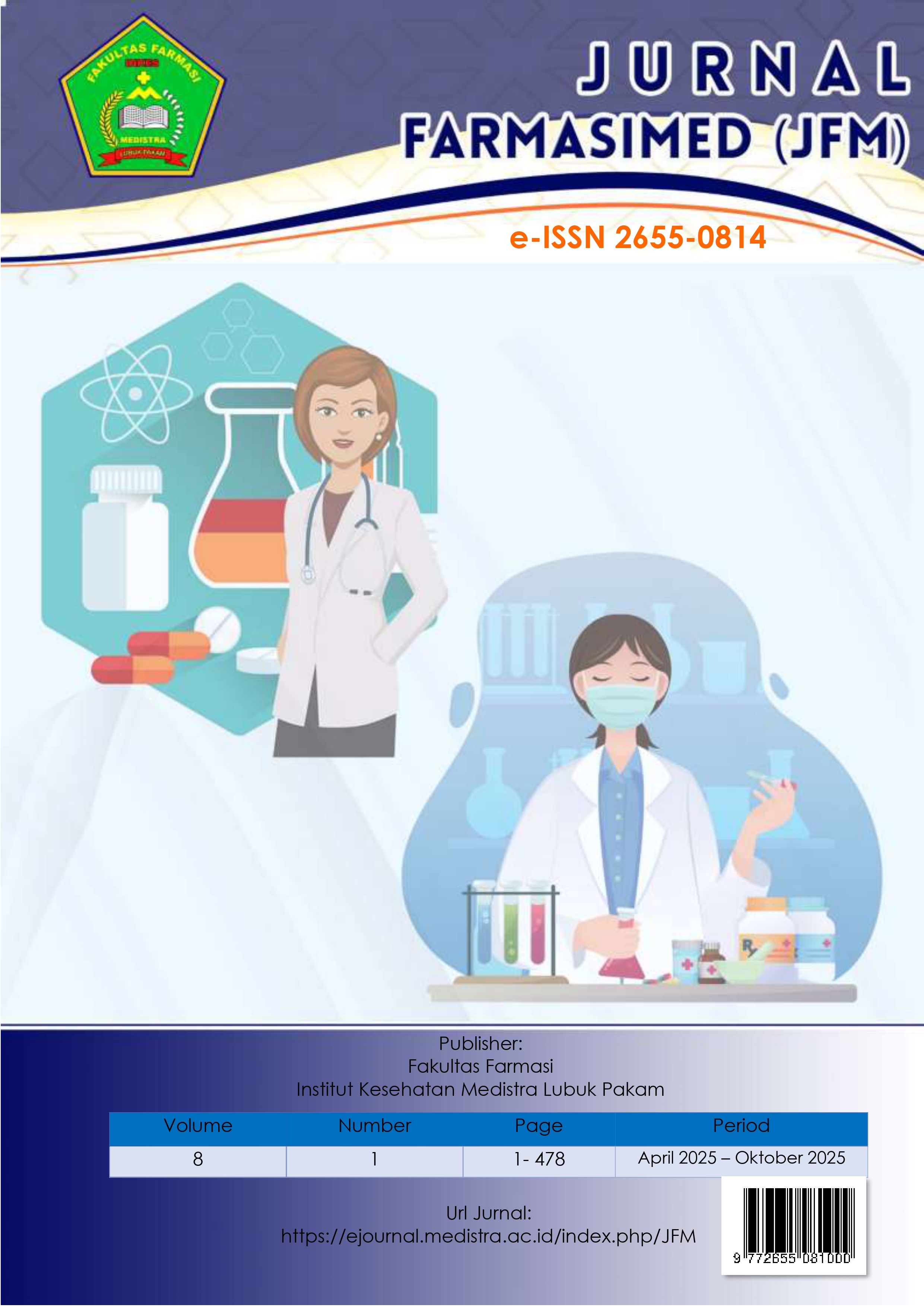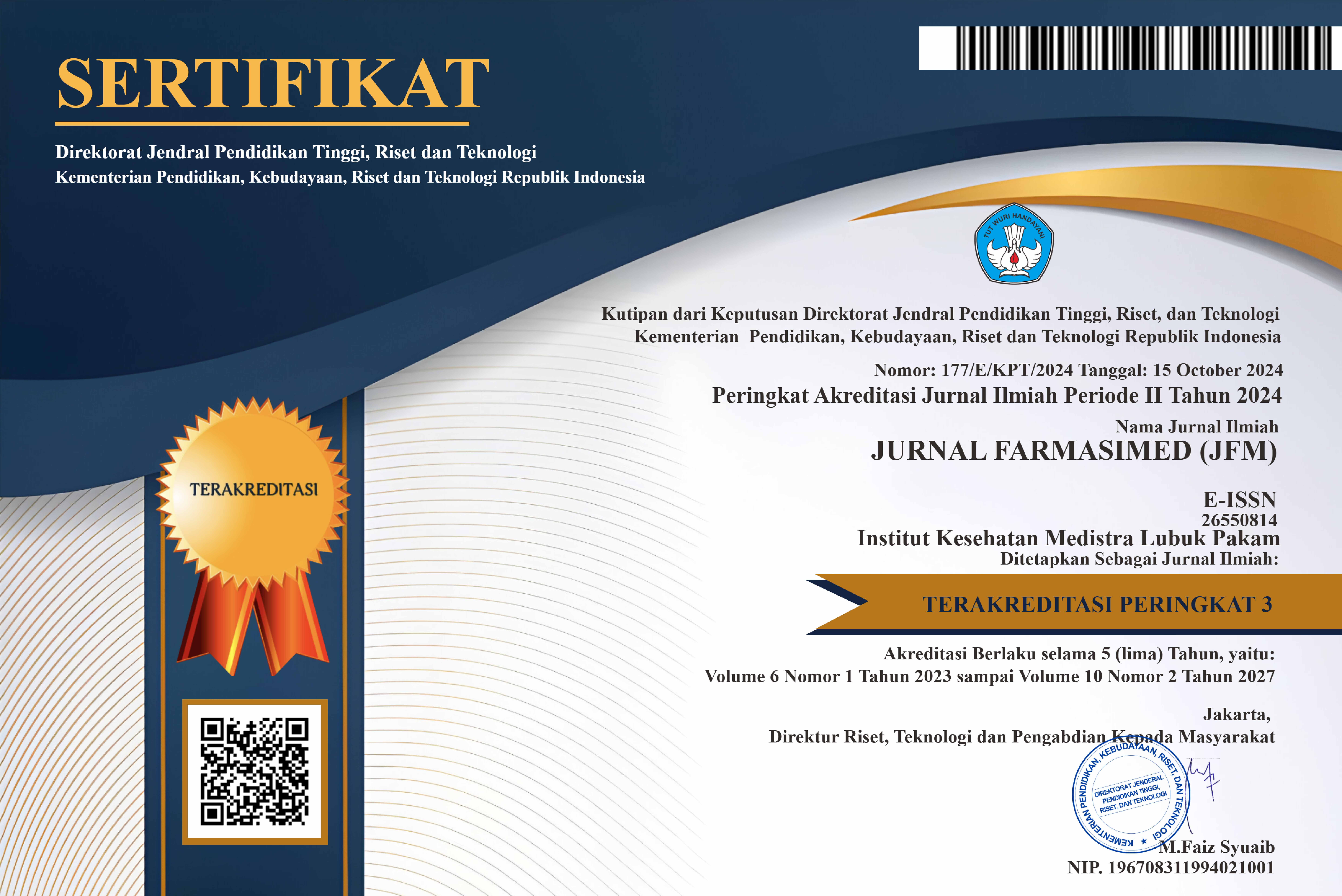Isolation and Structural Analysis of Active Antioxidant Phenolic Compounds from Elephantopus mollis Kunth
DOI:
https://doi.org/10.35451/a2hcyr24Keywords:
Elephantopus mollis , fenolik, antioksidan, asam kafeat, caffeic acidAbstract
Elephantopus mollis is a common weed found in West Sumatra, known for its diverse traditional uses and rich phytochemical content. This study aimed to isolate phenolic compounds and evaluate the antioxidant activity of the polar extract of E. mollis herb. The polar extract was obtained through successive extraction using solvents of increasing polarity. Separation of the polar extract was carried out using Amberlite XAD-4 resin chromatography with methanol and water eluents, followed by isolation through silica gel column chromatography using a step-gradient polarity elution system. The separation and isolation processes were monitored by thin-layer chromatography (TLC). Total phenolic content was determined by the Folin–Ciocalteu method, while antioxidant activity was assessed using the DPPH radical scavenging assay. Structural identification of the isolated compound was performed using UV-Vis, IR, NMR, and LC-MS spectroscopic techniques. Subfraction D of the polar extract exhibited a high phenolic content of 618.06 ± 3.38 mg GAE /g. From subfraction D, a phenolic compound designated D3a was isolated as a yellowish-white powder (95.30 mg) with an Rf value of 0.64, producing a dark blue color upon reaction with 10% FeCl₃. The antioxidant activity of compound D3a was classified as very strong, with an IC₅₀ value of 12.42 ppm. Based on physicochemical characterization, compound D3a was identified as caffeic acid with a molecular formula of C₉H₈O₄ and a molecular weight of 180.049.
Downloads
References
[1] M. Sukmadani Rusdi and M. Rifqi Efendi, “Pharmacological activity of Elephantopus mollis Kunth: A review,” J. Basic Appl. Pharmacol., vol. 1, no. 1, pp. 72–87, 2021, [Online]. Available: https://li01.tci-thaijo.org/index.php/JBAP
[2] T. T. Bich Ngoc, N. T. Hoai Nga, N. T. My Trinh, T. L. Thuoc, and D. T. Phuong Thao, “Elephantopus mollis Kunth extracts induce antiproliferation and apoptosis in human lung cancer and myeloid leukemia cells,” J. Ethnopharmacol., vol. 263, no. February, p. 113222, 2020, doi: 10.1016/j.jep.2020.113222.
[3] D. T. Phan and P. T. H. Nguyen, “Acute Toxicity and Liver Protective Effects of Elephantopus mollis H.B.K,” Trop. J. Nat. Prod. Res., vol. 5, no. 3, pp. 559–563, 2021.
[4] P. N.T.H., H. P.T., D. P.T., N. N.T.T., and K. D.T., “Acute toxicity, antibacterial and antioxidant abilities of Elephantopus mollis H.B.K. and Elephantopus scaber L.,” Can Tho Univ. J. Sci., vol. Vol.12(2), no. January, p. 9, 2020, doi: 10.22144/ctu.jen.2020.010.
[5] Z. N. Wu et al., “Sesquiterpene lactones from Elephantopus mollis and their anti-inflammatory activities,” Phytochemistry, vol. 137, pp. 81–86, 2017, doi: 10.1016/j.phytochem.2017.01.020.
[6] H. Li et al., “EM23, a natural sesquiterpene lactone from Elephantopus mollis, induces apoptosis in human myeloid leukemia cells through thioredoxin- and reactive oxygen species-mediated signaling pathways,” Front. Pharmacol., vol. 7, no. MAR, pp. 1–15, 2016, doi: 10.3389/fphar.2016.00077.
[7] J. Yang et al., “EM-2 inhibited autophagy and promoted G2/M phase arrest and apoptosis by activating the JNK pathway in hepatocellular carcinoma cells,” Acta Pharmacol. Sin., vol. 42, no. 7, pp. 1139–1149, 2021, doi: 10.1038/s41401-020-00564-6.
[8] D. N. Olennikov and N. K. Chirikova, “Phenolic Compounds of Six Unexplored Asteraceae Species from Asia: Comparison of Wild and Cultivated Plants,” Horticulturae, vol. 10, no. 5, pp. 1–23, 2024, doi: 10.3390/horticulturae10050486.
[9] A. Zeb, “Concept, mechanism, and applications of phenolic antioxidants in foods,” J. Food Biochem., vol. 44, no. 9, pp. 1–22, 2020, doi: 10.1111/jfbc.13394.
[10] N. Kumar and N. Goel, “Phenolic acids: Natural versatile molecules with promising therapeutic applications,” Biotechnol. Reports, vol. 24, p. e00370, 2019, doi: 10.1016/j.btre.2019.e00370.
[11] V. Verawati, A. Almahdy, F. Febriyenti, and P. D. Putra, “In Vitro and In Vivo Evaluation of Photoprotective Effect of Elephantopus mollis Extracts,” Trop J Nat Prod Res, vol. 6, no. 3, pp. 365–370, 2022, [Online]. Available: https://www.researchgate.net/profile/Oladipo-Olaniyi/publication/357648838_Tropical_Journal_of_Natural_Product_Research_Original_Research_Article_Enhanced_Production_Purification_and_Characterization_of_Pectinase_from_Aspergillus_flavus/links/61d7fb09e669
[12] G. T. M. Bitchagno et al., “Lc-tof-esi-ms patterns of hirsutinolide-like sesquiterpenoids present in the elephantopus mollis kunth extract and chemophenetic significance of its chemical constituents,” Molecules, vol. 26, no. 16, pp. 1–12, 2021, doi: 10.3390/molecules26164810.
[13] K. Chen, H. Lyu, S. Hao, G. Luo, S. Zhang, and J. Chen, “Separation of phenolic compounds with modified adsorption resin from aqueous phase products of hydrothermal liquefaction of rice straw,” Bioresour. Technol., vol. 182, pp. 160–168, 2015, doi: 10.1016/j.biortech.2015.01.124.
[14] N. Siddiqui, A. Rauf, A. Latif, and Z. Mahmood, “Spectrophotometric determination of the total phenolic content, spectral and fluorescence study of the herbal Unani drug Gul-e-Zoofa (Nepeta bracteata Benth),” J. Taibah Univ. Med. Sci., vol. 12, no. 4, pp. 360–363, 2017, doi: 10.1016/j.jtumed.2016.11.006.
[15] C. Wang et al., “Influence of Solvent Selection on the Crystallizability and Polymorphic Selectivity Associated with the Formation of the ‘Disappeared’ Form I Polymorph of Ritonavir,” Mol. Pharm., vol. 21, no. 7, pp. 3525–3539, 2024, doi: 10.1021/acs.molpharmaceut.4c00234.
[16] R. Abu Khalaf, A. A. Alhusban, E. Al-Shalabi, I. Al-Sheikh, and D. A. Sabbah, Isolation and structure elucidation of bioactive polyphenols, 1st ed., vol. 63. Elsevier Inc., 2019. doi: 10.1016/B978-0-12-817901-7.00010-1.
[17] J. Rohmah, “Antioxidant Activities Using DPPH, FIC, FRAP, AND ABTS Methods from Ethanolic Extract of Lempuyang Gajah Rhizome (Zingiber zerumbet (L.) Roscoeex Sm.),” J. Kim. Ris., vol. 7, no. 2, pp. 152–166, 2022, doi: 10.20473/jkr.v7i2.34493.
[18] L. Campone, R. Celano, S. Rizzo, A. L. Piccinelli, L. Rastrelli, and M. Russo, “Development of an Enriched Polyphenol (Natural Antioxidant) Extract from Orange Juice (Citrus sinensis) by Adsorption on Macroporous Resins,” J. Food Qual., vol. 2020, 2020, doi: 10.1155/2020/1251957.
[19] J. Tosovic, “Spectroscopic features of caffeic acid: Theoretical study,” Kragujev. J. Sci., vol. 39, no. 39, pp. 99–108, 2017, doi: 10.5937/kgjsci1739099t.
[20] J. Bell, P. Nel, and B. Stuart, “Non-invasive identification of polymers in cultural heritage collections: evaluation, optimisation and application of portable FTIR (ATR and external reflectance) spectroscopy to three-dimensional polymer-based objects,” Herit. Sci., vol. 7, no. 1, pp. 1–18, 2019, doi: 10.1186/s40494-019-0336-0.
[21] V. Raks, H. Al-Suod, and B. Buszewski, “Isolation, Separation, and Preconcentration of Biologically Active Compounds from Plant Matrices by Extraction Techniques,” Chromatographia, vol. 81, no. 2, pp. 189–202, 2018, doi: 10.1007/s10337-017-3405-0.
[22] H. Rho, K. Chon, J. Park, and J. Cho, “Rapid and effective isolation of dissolved organic matter using solid-phase extraction cartridges packed with amberlite XAD 8/4 resins,” Water (Switzerland), vol. 11, no. 1, 2019, doi: 10.3390/w11010067.
[23] W. Dong, Q. Zhao, J. Zhao, J. Zhang, Y. Wang, and Y. Qiao, “Qualitative analysis of aromatic compounds via 1D TOCSY techniques,” Magn. Reson. Lett., vol. 4, no. 1, p. 100091, 2024, doi: 10.1016/j.mrl.2023.11.003.
[24] R. Gunawan and A. B. D. Nandiyanto, “How to read and interpret 1h-nmr and 13c-nmr spectrums,” Indones. J. Sci. Technol., vol. 6, no. 2, pp. 267–298, 2021, doi: 10.17509/ijost.v6i2.34189.
[25] S. Tassoti, M. Walenta, A. Pöcheim, K. Buchberger, O. Kunert, and K. Zangger, “Solvent-independent determination of heteroatom protonation states from NMR spectra by differential deuterium isotope shifts,” Analyst, vol. 144, no. 24, pp. 7463–7467, 2019, doi: 10.1039/c9an01364d.
[26] P. K. Agrawal and G. Blunden, “Methoxy 13C NMR Chemical Shift as a Molecular Descriptor in the Structural Analysis of Flavonoids and Other Phenolic Compounds,” Nat. Prod. Commun., vol. 18, no. 6, 2023, doi: 10.1177/1934578X231171002.
[27] A. Ehnbom, M. B. Hall, and J. A. Gladysz, “Origin of Shielding and Deshielding Effects in NMR Spectra of Organic Conjugated Polyynes,” Org. Lett., vol. 21, no. 3, pp. 753–757, 2019, doi: 10.1021/acs.orglett.8b03990.
[28] J. Yuan, Y. Wang, S. Mi, J. Zhang, and Y. Sun, “Rapid screening and characterization of caffeic acid metabolites in rats by UHPLC-Q-TOF mass spectrometry,” Trop. J. Pharm. Res., vol. 20, no. 2, pp. 389–401, 2021, doi: 10.4314/tjpr.v20i2.25.
[29] F. A. Khan, A. Maalik, and G. Murtaza, “Inhibitory mechanism against oxidative stress of caffeic acid,” J. Food Drug Anal., vol. 24, no. 4, pp. 695–702, 2016, doi: 10.1016/j.jfda.2016.05.003.
Downloads
Published
Issue
Section
License
Copyright (c) 2025 Verawati Verawati, Almahdy Almahdy, Febriyenti Febriyenti, Deddi Prima Putra

This work is licensed under a Creative Commons Attribution-NoDerivatives 4.0 International License.
Copyright in each article is the property of the Author.

























